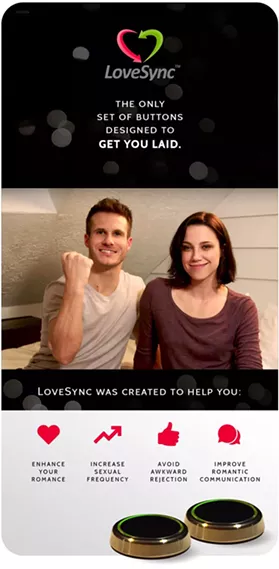A new Kickstarter campaign has a terrible solution to your relationship problems
Posted on February 20, 2019 by Jessie Sage
Originally Published in Pittsburgh City Paper.
Three weeks ago, a Kickstarter campaign launched for a piece of technology aimed at improving couples’ communication about sex. LoveSync promises a solution to mismatched libidos. It offers “an entirely new way to increase your sexual frequency and boost your romantic relationship with the simple press of a button.”
The idea is simple. Each person in a couple places a button on their bedside table, which they press when they are in the mood for sex. If both partners press the button, there is a match and they are alerted that it’s sexy time. If one partner presses the button and the other doesn’t, “no one will be the wiser.”
LoveSync’s claim is that folks will be more likely to assert their desire for sex if they don’t fear rejection; and direct rejection, of course, is impossible if your partner only knows you want to have sex when they are also in the mood.
The Kickstarter campaign met its goal in just two days and has now raised close to $13,000. Despite its momentary popularity, LoveSync is a terrible idea— so bad, in fact, we might as well rename it “The Divorce Button.” It’s a technological solution to an interpersonal or relational problem. Our sexual needs, desires, and insecurities are complex and cannot be easily boiled down to an on/off switch, and glossing over this complexity is likely to deepen the problem.
It’s not inherently a problem in a relationship to have libidos that don’t exactly match up. In fact, it’s a normal situation that partners have to continually negotiate as they both develop and change over time. Partners are not mirror images of each other.
The solution is not to reduce each other to human sex dispensers by eliminating any conversation that may lead to conflict; instead, real solutions lie in working to understand the root of conflicting desires and negotiating compromises that make both partners feel seen and cared for.
In my own marriage, issues of mismatched libido often aren’t about sex drive at all, but rather about how we individually relate to sex. When we are feeling disconnected because of stress or conflict, I often desire sex because sex helps me to bridge emotional distance. But for my partner, sex is something that flows out of emotional connection, and is therefore not possible until we resolve the issues between us.
At times like this, we have had to communicate so that he doesn’t feel pressured into sex that doesn’t feel natural to him, and I don’t feel cut off from the connection I desire. This sometimes involves facing our conflicts head on and taking steps to rekindle our closeness in sexual and non-sexual ways. But hiding behind technology would have prevented us to having the necessary conversations that shed light on this pattern.
This technology reduces sexuality to a yes or a no and doesn’t take into consideration that people want different things at different times. These shifts and conflicts need to be continuously communicated and negotiated, and this can only happen through an openness, which includes vulnerability, even in the face of a possible rejection. Better sex comes from better communication and care and concern for your partner, not fancier technology that protects you from your own feelings.

